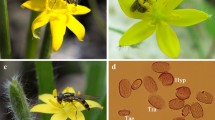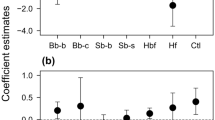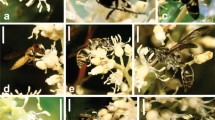Abstract
The pump pollination mechanism is typical of basal clades within Papilionoideae and might be associated with less efficient pollen transfer systems, while the explosive tripping mechanism is considered more advanced and might represent the highest expression of the trend in pollen economy. Crotalaria pumila, C. stipularia, Desmodium incanum and D. subsericeum present secondary pollen presentation with pump and explosive pollination mechanisms, respectively. In the present study, we evaluate and compare (1) pollen removal, (2) pollen deposition and (3) pollen transfer efficiency of both mechanisms, considering single visits by Megachile spp., common pollinators of the four plant species in Salta Province, Argentina. Comparisons of visit durations are made in relation to the type of mechanism and rewards offered. We detected significant differences between both mechanisms in the proportion of pollen grains removed and deposited in a flower after a single visit of Megachile. We found that efficiency in pollen transfer was significantly higher for explosive mechanism (2.13 ± 0.42 pollen grains deposited per 100 removed) than for pump mechanism (0.33 ± 0.17 pollen grains deposited per 100 removed). This is the first study that compares efficiency between pollination mechanisms in this group of plants.




Similar content being viewed by others
References
Alemán M (2014) Biología floral, mecanismos de polinización y sistema reproductivo de Papilionoideas nativas del Valle de Lerma (Salta). Tesis de Doctorado en Ciencias Biológicas. Universidad Nacional de Salta
Alemán M, Figueroa-Fleming T, Etcheverry A, Sühring S, Ortega-Baes P (2014) The explosive pollination mechanism in Papilionoideae (Leguminosae): an analysis with three Desmodium species. Plant Syst Evol 300:177–186
Arroyo MTK (1981) Breeding systems and pollination biology in Leguminosae. In: Polhill RM, Raven PH (eds) Advances in legume systematics, Part 2. Royal Botanic Garden, Kew, pp 723–769
Bianchi AR (1996) Temperaturas medias estimadas para la región noroeste de Argentina. INTA, Salta
Bianchi AR, Yáñez CE (1992) Las precipitaciones en el noroeste argentino. INTA, Salta
Brito VLG, PinheiroM, Sazima M (2010) Sophora tomentosa and Crotalaria vitellina (Fabaceae): reproductive biology and interactions with bees in the restinga of Ubatuba, São Paulo. Biota Neotrop 10: 185–192
Castellanos MC, Wilson P, Keller SJ, Wolfe AD, Thomson JD (2006) Anther evolution: pollen presentation strategies when pollinators differ. Am Nat 167:288–296
Conover WJ (1999) Practical nonparametric statistics. Wiley, New York
Córdoba SA, Cocucci AA (2011) Flower power: its association with bee power and floral functional morphology in papilionate legumes. Ann Bot (Lond) 108:919–931
Dafni A (1992) The principles of pollination ecology. Oxford University Press, New York
Di Rienzo JA, Casanoves F, Balzarini MG, Gonzalez L, Tablada M, Robledo CW (2010) InfoStat versión 2010. Grupo InfoStat, FCA, Universidad Nacional de Córdoba, Argentina
Du Puy DJ, Labat JN (2002) Crotalaria. In: Du Puy DJ (ed) The Leguminosae of Madagascar. Royal Botanic Gardens, Kew, pp. 672–708
Endress PK (1996) Diversity and evolutionary biology of tropical flowers. Cambridge University Press, Cambridge
Etcheverry AV (2001a) Dynamic dispensing of pollen: an empirical study. In: Proceedings of the 8th international pollination symposium on acta horticulture, vol 561, pp 67–70
Etcheverry AV (2001b) Floral biology and pollination in Crotalaria stipularia (Fabaceae: Papilionoideae). In: Proceedings of the 8th international pollination symposium on acta horticulture, vol 561, pp 339–342
Etcheverry AV, Protomastro JJ, Westerkamp C (2003) Delayed autonomous self-pollination in the colonizer Crotalaria micans (Fabaceae: Papilionoideae): structural and functional aspects. Plant Syst Evol 239:15–28
Etcheverry AV, Alemán MM, Figueroa Fleming T (2008) Flower morphology, pollination biology and mating system of the complex flower of Vigna caracalla (Fabaceae: Papilionoideae). Ann Bot (Lond) 102:305–316
Etcheverry AV, Alemán MM, Figueroa-Fleming T, López-Spahr D, Gómez CA, Yáñez C, Figueroa-Castro DM, Ortega-Baes P (2012) Pollen:ovule ratio and its relationship with other floral traits in Papilionoideae (Leguminosae): an evaluation with Argentine species. Plant Biol 14:271–278
Faegri K, van der Pijl L (1979) The principles of pollination ecology. 2nd Ed. Pergamon, Oxford
Figueroa Fleming T (2014) Interacciones planta-polinizador en Papilionoideas (Leguminosae) simpátricas nativas de Salta, Argentina. Tesis de Doctorado en Ciencias Biológicas. Universidad Nacional de Salta
Galen C, Stanton ML (1989) Bumble bee pollination and floral morphology: factors influencing pollen dispersal in the alpine sky pilot, Polemonium viscosum (Polemoniaceae). Am J Bot 76:419–426
Galloni M, Cristofolini G (2003) Floral rewards and pollination in Cytiseae (Fabaceae). Plant Syst Evol 238:127–137
Galloni M, Podda L, Vivarelli D, Cristofolini G (2007) Pollen presentation, pollen–ovule ratios, and other reproductive traits in Mediterranean legumes (Fam. Fabaceae-Subfam. Faboideae). Plant Syst Evol 266:147–164
Harder LD (1990) Pollen removal by bumble bees and its implications for pollen dispersal. Ecology 71:1110–1125
Harder LD, Barret SCH (1993) Pollen removal from tristylous Pontederia cordata: effects of anther position and pollinator specialization. Ecology 74:1059–1072
Harder LD, Thomson JD (1989) Evolutionary options for maximizing pollen dispersal of animal-pollinated plants. Am Nat 133:323–344
Harder LD, Wilson WG (1994) Floral evolution and male reproductive success: optimal dispensing schedules for pollen dispersal by animal-pollinated plants. Evol Ecol 8:542–559
Harder LD, Thomson JD, Cruzan MB, Unnasch RS (1985) Sexual reproduction and variation in floral morphology in an ephemeral vernal lily, Erythronium americanum. Oecologia 67:286–291
Haynes J, Mesler M (1984) Pollen foraging by bumblebees: Foraging patterns and efficiency on Lupinus polyphyllus. Oecologia 61:249–253
Herrera CM (1987) Components of pollinator ‘‘quality’’: comparative analysis of a diverse insect assemblage. Oikos 50:79–90
Huang L, Jin L, Zhang S, Li J, Yang Y, Zhang X, Wang X (2013) Pollen release mechanisms of papilionaceous plants (Faboideae). Acta Pratacult Sin 22: 305–314
Jacobi CM, Ramalho M, Silva M (2005) Pollination biology of the exotic rattleweed Crotalaria retusa L. (Fabaceae) in NE Brazil. Biotropica 37:357–363
Juncosa AM, Webster BD (1989) Pollination in Lupinus nanus subsp. latifolius (Leguminosae). Am J Bot 76: 59–66
Kearns CA, Inouye DW (1993) Techniques for pollination biologists. University Press of Colorado, Niwot
King C, Ballantyne G, Willmer PG (2013) Why flower visitation is a poor proxy for pollination: measuring single-visit pollen deposition, with implications for pollination networks and conservation. Methods Ecol Evol 4:811–818
Kittelson PM, Maron JL (2000) Outcrossing rate and inbreeding depression in the perennial yellow bush lupine, Lupinus arboreus (Fabaceae). Am J Bot 87: 652–660
Lavin M, Herendeen PS, Wojciechowski MF (2005) Evolutionary rates analysis of Leguminosae implicates a rapid diversification of lineages during the Tertiary. Syst Biol 54: 575–594
Le Roux MM, Van Wyk BE (2012) The systematic value of flower structure in Crotalaria and related genera of the tribe Crotalarieae (Fabaceae). Flora 207:414–426
Leppik EE (1966) Floral evolution and evolution in Leguminosae. Ann Bot Fennici 3: 99–308
López J, Rodríguez-Riaño T, Ortega-Olivencia A, Devesa JA, Ruiz T (1999) Pollination mechanisms and pollen-ovule ratios in some Genisteae (Fabaceae) from Southwestern Europe. Plant Syst Evol 216:23–47
Michener CD, Winston ML, Jander R (1978) Pollen manipulation and related activities and structures in bees of the family Apidae. Univ Kansas Sci Bull 51:575–601
Ne’eman G, Jurgens A, Newstrom-Lloyd LE, Potts SG, Dafni A (2010) A framework for comparing pollinator performance: effectiveness and efficiency. Biol Rev 85:435–451
Olson DM, Dinerstein E, Wikramanayake ED, Burgess ND, Powell GVN, Underwood EC, D’Amico JA, Itoua I, Strand HE, Morrison JC, Loucks CJ, Allnutt TF, Ricketts TH, Kura Y, Lamoreux JF, Wettengel WW, Hedao P, Kassem KR (2001) Terrestrial ecoregions of the worlds: a new map of life on earth. Bioscience 51:933–938
Polhill RM (1976) Genisteae (Adans.) Benth. and related tribes (Leguminosae). Syst Bot 1: 143–368
Polhill RM (1982) Crotalaria in Africa and Madagascar. A. A. Balkema, Rotterdam
Proctor M, Yeo P, Lack A (1996) The natural history of pollination. Timber Press, Portland
Rademaker MCJ, De Jong TJ, Klinkhamer PGL (1997) Pollen dynamics of bumble-bee visitation on Echium vulgare. Funct Ecol 11:554–563
Rodríguez-Riaño T, Ortega-Olivencia A, Devesa AJ (1999) Reproductive biology in two Genisteae (Papilionoideae) endemic of the Western Mediterranean Region: Cytisus striatus and Retama sphaerocarpa. Can J Bot 77:809–820
Small E (1988) Pollen–ovule patterns in tribe Trifoliae (Leguminosae). Plant Syst Evol 160:195–205
Snow AA, Roubik DW (1987) Pollen deposition and removal by bees visiting two tree species in Panama. Biotropica 19:57–63
Solomon Raju AJ, Purnachandra Rao S (2006) Explosive pollen release and pollination as a function of nectar-feeding activity of certain bees in the biodiesel plant, Pongamia pinnata (L.) Pierre (Fabaceae). Curr Sci 90: 7–10
Stanley DA, Otieno M, Steijven J, Sandler Berlin E, Piiroinen T, Willmer P, Nuttman C (2016) Pollination ecology of Desmodium setigerum (Fabaceae) in Uganda: do big bees do it better? J Pollinat Ecol 19:43–49
Suzuki N (2003) Significance of flower exploding pollination on the reproduction of the Scotch broom, Cytisus scoparius (Leguminosae). Ecol Res 18:523–532
Thomson JD (1983) Component analysis of community-level interactions in pollination systems. In: Jones CE, Little RJ (eds) Handbook of experimental pollination biology. Van Nostrand Reinhold, New York, pp 451–460
Thomson JD, Wilson P, Valenzuela M, Malzone M (2000) Pollen presentation and pollination syndromes, with special reference to Penstemon. Plant Species Biol 15:11–29
Thorp RW (1979) Structural, behavioral, and physiological adaptations of bees (Apoidea) for collecting pollen. Ann Mo Bot Gard 66:788–812
Westerkamp C (1997) Keel blossoms: bee flowers with adaptations against bees. Flora 192:125–132
Westerkamp C, Weber A (1999) Keel flowers of the Polygalaceae and Fabaceae: a functional comparison. Bot J Linn Soc 129:207–221
Willmer P, Stanley DA, Steijven K, Matthews IM, Nuttman CV (2009) Bidirectional flower color and shape changes allow a second opportunity for pollination. Curr Biol 19:919–923
Wilson P, Thomson JD (1991) Heterogeneity among floral visitors leads to discordance between removal and deposition of pollen. Ecology 72:1503–1507
Yeo PF (1993) Secondary pollen presentation. Form, function and evolution. Springer, New York
Young HJ, Stanton ML (1990) Influences of floral variation on pollen removal and seed production in wild radish. Ecology 71:536–547
Zych M, Gold J, Stpiczynska M (2013) The most effective pollinator revisited: pollen dynamics in a spring-flowering herb. Arthropod-Plant Interactions 7:315–322
Acknowledgements
Insects were identified by Dr. Alberto Abrahamovich (Museo de la Plata). Carolina Noemí Yañez and Andrea Florencia Romero helped with field work. The authors thank María Schulze, Francisco Sylvester and Hugo Lesser for their assistance with the English version of the manuscript. This research was supported by grants from Consejo Nacional de Investigaciones Científicas y Técnicas and Consejo de Investigación de la Universidad Nacional de Salta.
Author information
Authors and Affiliations
Corresponding author
Additional information
Handling Editor: Isabel Alves dos Santos and Isabel Machado.
Rights and permissions
About this article
Cite this article
Figueroa Fleming, T., Etcheverry, Á.V. Comparing the efficiency of pollination mechanisms in Papilionoideae. Arthropod-Plant Interactions 11, 273–283 (2017). https://doi.org/10.1007/s11829-017-9515-7
Received:
Accepted:
Published:
Issue Date:
DOI: https://doi.org/10.1007/s11829-017-9515-7




